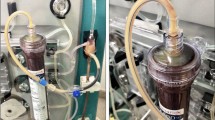Abstract
To this day, the pathophysiology and risk factors of propofol infusion syndrome (PRIS) remain unknown. Moreover, there is no widely accepted definition of PRIS, even though it is a potentially fatal condition. While many suspected cases of PRIS have been reported in both pediatric and adult populations, the actual propofol plasma concentration (Cp) has never been clarified. In this clinical report, we described the first suspected PRIS case in which the propofol Cp was measured 25 min after 226 min of propofol infusion (7.2 µg/mL), which was 12 times higher than the predicted value (0.6 µg/mL). In the presented case, we observed gradually progressive uncontrollable hypercapnia and tachycardia, followed by severe lactic acidosis during surgical anesthesia based on the target-controlled infusion of propofol. Levels of liver enzymes were slightly elevated which suggests little or no liver damage though propofol is mainly metabolized by the liver. Meanwhile, renal impairment, a common secondary feature of PRIS, occurred concomitantly when hypercapnia and metabolic acidosis were manifested. In this case, low or delayed propofol clearance might have been a triggering factor causing severe lactic acidosis.

Similar content being viewed by others
References
Bray RJ. Propofol infusion syndrome in children. Paediatr Anaesth. 1998;8:491–9.
Sumi C, Okamoto A, Tanaka H, Nishi K, Kusunoki M, Shoji T, Uba T, Matsuo Y, Adachi T, Hayashi J, Takenaga K, Hirota K. Propofol induces a metabolic switch to glycolysis and cell death in a mitochondrial electron transport chain-dependent manner. PLoS ONE. 2018;15(13):e0192796.
Vollmer JP, Haen S, Wolburg H, Lehmann R, Steiner J, Reddersen S, Fend F, Fallier-Becker P. Propofol related infusion syndrome: ultrastructural evidence for a mitochondrial disorder. Crit Care Med. 2018;46:e91–e9494.
Wolf A, Weir P, Segar P, Stone J, Shield J. Impaired fatty acid oxidation in propofol infusion syndrome. Lancet. 2001;357:606–7.
Hemphill S, McMenamin L, Bellamy MC, Hopkins PM. Propofol infusion syndrome: a structured literature review and analysis of published case reports. Br J Anaesth. 2019;122:448–59.
Masui K, Kira M, Kazama T, Hagihira S, Mortier EP, Struys MM. Early phase pharmacokinetics but not pharmacodynamics are influenced by propofol infusion rate. Anesthesiology. 2009;111:805–17.
Marsh B, White M, Morton N, Kenny GN. Pharmacokinetic model driven infusion of propofol in children. Br J Anaesth. 1991;67:41–8.
Kirkpatrick T, Cockshott ID, Douglas EJ, Nimmo WS. Pharmacokinetics of Propofol (diprivan) in elderly patients. Br J Anaesth. 1988;60:146–50.
Servin F, Farinotti R, Haberer JP, Desmonts JM. Propofol infusion for maintenance of anesthesia in morbidity obese patients receiving nitrous oxide. Anesthesiology. 1993;78:657–65.
Masui K, Upton RN, Doufas AG, Coetzee JF, Kazama T, Mortier EP, Struys MMRF. The performance of compartmental and physiologically based recirculatory pharmacokinetic models for Propofol: a comparison using bolus, continuous, and target-controlled infusion data. Anesth Analg. 2010;111:368–79.
Dawidowicz AL, Fornal E, Fijalkowska A. Determining the influence of storage time on the level of propofol in blood samples by means of chromatography. Biomed Chromatogr. 2000;14:249–55.
Dawidowicz AL, Fijalkowska A, Nestorowicz A, Fornal E. The influence of blood sample storage time on the propofol concentration in plasma and solid blood elements. Biomed Chromatogr. 2001;15:408–12.
Itakura S, Masui K, Kazama T. Rapid infusion of hydroxyethyl starch 70/0.5 but not acetate ringer's solution decreases the plasma concentration of propofol during target-controlled infusion. Anesthesiology. 2016;125:304–12.
Al-Jahdari WS, Yamamoto K, Hiraoka H, Nakamura K, Goto F, Horiuchi R. Prediction of total propofol clearance based on enzyme activities in microsomes from human kidney and liver. Eur J Clin Pharmacol. 2006;62:527–33.
Hiraoka H, Yamamoto K, Miyoshi S, Morita T, Nakamura K, Kadoi Y, Kunimoto F, Horiuchi R. Kidneys contribute to the extrahepatic clearance of propofol in humans, but not lungs and brain. Br J Clin Pharmacol. 2005;60:176–82.
Cortínez LI, De la Fuente N, Eleveld DJ, Oliveros A, Crovari F, Sepulveda P, Ibacache M, Solari S. Performance of propofol target-controlled infusion models in the obese: pharmacokinetic and pharmacodynamic analysis. Anesth Analg. 2014;119:302–10.
Krajčova A, Waldauf P, Anděl M, Duška F. Propofol infusion syndrome: a structured review of experimental studies and 153 published case reports. Crit Care. 2015;19:398.
Kill C, Leonhardt A, Wulf H. Lacticacidosis after short-term infusion of propofol for anaesthesia in a child with osteogenesis imperfecta. Paediatr Anaesth. 2003;13:823–6.
Takita A, Masui K, Kazama T. On-line monitoring of end-tidal propofol concentration in anesthetized patients. Anesthesiology. 2007;106:659–64.
Acknowledgements
The authors are indebted to Takashi Maruyama, MD, PhD, Taiichi Saito, MD, PhD and Atsushi Fukui, MD, PhD (Department of Neurosurgery, Tokyo Women’s Medical University) for their invaluable support.
Author information
Authors and Affiliations
Corresponding author
Ethics declarations
Conflict of interest
The present research was supported solely by the hospital's and/or departmental sources. None of the authors has any financial interest in products related to this report. This report was previously presented as a poster at Euroanaesthesia 2018 in Copenhagen, Denmark.
Additional information
Publisher's Note
Springer Nature remains neutral with regard to jurisdictional claims in published maps and institutional affiliations.
About this article
Cite this article
Ichikawa, T., Okuyama, K., Kamata, K. et al. Suspected propofol infusion syndrome during normal targeted propofol concentration. J Anesth 34, 619–623 (2020). https://doi.org/10.1007/s00540-020-02773-z
Received:
Accepted:
Published:
Issue Date:
DOI: https://doi.org/10.1007/s00540-020-02773-z




